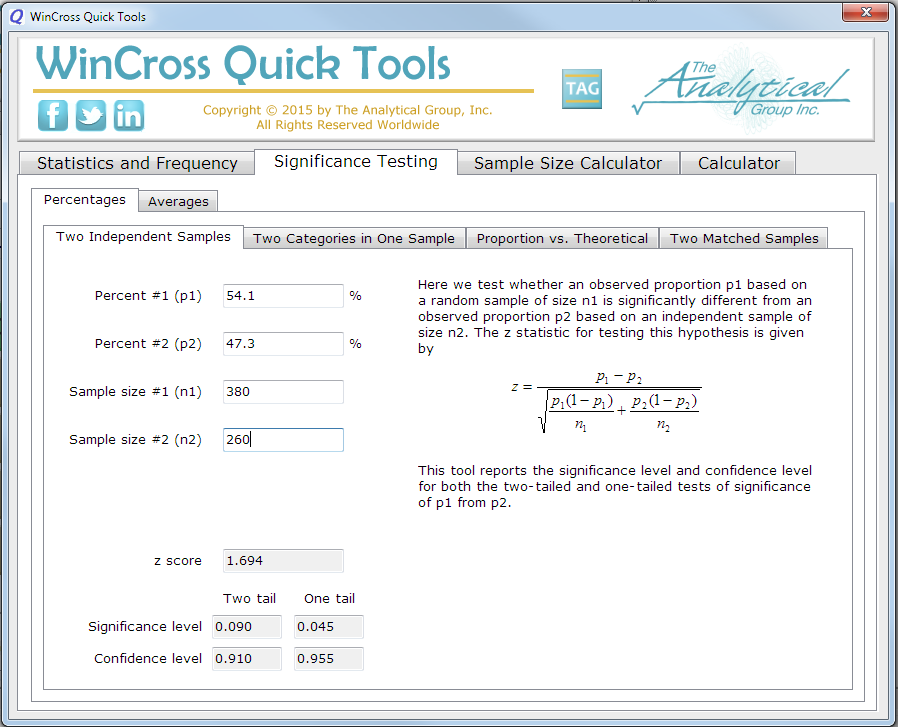Sample Size Calculator Excel File
Sample Size Calculator in Excel What's Cool About the QI Macros Sample Size Calculator? The QI Macros Sample Size Calculator works with both variable (measured) and attribute (counted) data. Just click on the QI Macros menu, then Calculators, then Sample Size Calculator. You should see the following: To calculate a sample size you need to know: • The confidence level required (90%, 95%, 99%) α = 0.1, 0.05, 0.01 (Type I Error) • The Power required (80%, 85%, 90%) β = 0.2, 0.15, 0.1 (Type II Error) • The desired width of the confidence interval δ - Maximum allowable error of the estimate = 1/2 * tolerance • σ - estimated standard deviation ( 0.167 = 1/6) The defaults are set to standard parameters, but can be changed.

Confidence Level In sampling, you want to know how well a sample reflects the total population. The α = 0.05 - 95% confidence level means you can be 95% certain that the sample reflects the population within the confidence interval. Step 1 - Choose alpha α = 0.05 - 95% Confidence Level Step 2 - Choose beta β = 0.1 - 90% Power Confidence Interval The confidence interval represents the range of values which includes the true value of the population parameter being measured.
Windows 10 Iso 32 Bit Highly Compressed Movies. Step 3 - Set the confidence interval to half the tolerance or maximum allowable error of the estimate. (e.g., + 0.05, 2, etc.) Step 4 - Attribute data (pass/fail, etc.) - Set percent defects to 0.5 If 95 out of 100 are good and only 5 are bad, then you wouldn't need a very large sample to estimate the population. If 50 are bad and 50 are good, you'd need a much larger sample to achieve the desired confidence level. Since you don't know beforehand how many are good or bad, you can set the attribute field to (50% or 0.5). Step 5 - Variable Data - Enter Standard Deviation If you know the standard deviation of your data (from past studies), then you can use the standard deviation. If you know the specification tolerance, then you can use (maximum value - minimum value)/6 as your standard deviation.
Sample Size Calculator in Excel for Lean Six Sigma and TQM - Download QI Macros 30 day trial. Obulis Full Game Premium Version. Sample size are interrelated and that fixing any three will determine fourth. Non-centrality Parameter. Tartan tab appears on Excel Ribbon when file opens. Contributed by John Marshall Instructions: In the workbook Format: xlsm Macros: Yes Size: 143kb Download: tartanmakermacro.zip: UF0038 - Hyperlinks Run Command Files Use hyperlinks and a background macro, to run command or script files from Excel, with a single click.
(The default is 1/6 = 0.167). Step 6 - Enter the total population (if known) Using the default values (95%, + 0.05, Stdev = 0.167) Step 7- Read the Sample Size Use the sample size calculated for your type of data: Attribute or Variable. Variable Sample Size: If we are using variable data and just α the sample size would be 43. Using α and β the sample size would be 118. *** Please Note: Our Sampling Tables are identical to that of the ANSI Z1.4 tables. QI Macros offers general inspection levels, however not special inspection levels. Attribute Example Attribute Sample Size: What if you were using attribute data, (e.g., counting the number of defective coins in a vat at the Denver Mint) but didn't know how many coins were in the vat?
You'd need 384 coins to be 95% confident that the coins fell within the 5% interval. What if you knew there were 1000 coins in the vat (population known)? You only need 278 to be confident.
What if you changed the confidence interval to be + 0.1? You only need 88 to be 95% confident. Variable Example A sample must be selected to estimate the mean length of a part in a population. Almost all production falls between 2.009 and 2.027 inches.
Estimated standard deviation = (2.027 - 2.009) / 6 = 0.003. And you want to be 95% confident that the sample is within +/- 0.001 of the true mean. Enter the data as shown below: You need 35 samples using α alone and 95 using α and β together. Why Choose QI Macros Statistical Software for Excel?
Fear these technical challenges no longer. The Oregon Audits blog will be rolling out new posts covering practical and useful audit tools. Random sampling will be our first topic, but if you have any requests please don’t hesitate to. What the heck is random sampling? Random sampling is useful to gain an understanding of a population without examining every file. By randomly selecting our sample, bias is also eliminated because every “file” has an equal chance of being selected. One word of caution though, if you are trying to look for outliers you will need a large sample size.
That begs the question: How big of a sample do I need to take? The short answer: 30 is usually good. If it is a simple test and not the critical element of your finding, 30 should cover you almost every time. The longer answer is it depends. You need to consider your objectives, how confident you want to be about your results, how much margin of error is tolerable, and how big and varied the population is.